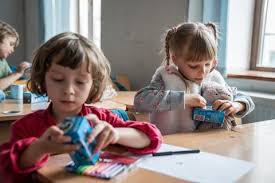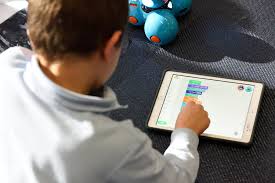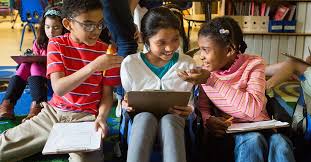What games can 1 year olds play?
Here are 5 fun ideas for games and toys you can play with your 1-year-old.
- Stacking Blocks. There’s just something about stacking blocks, or really anything that will stack, that entertains baby boy.
- Puzzles.
- Where’s the Baby?
- Lift-the-Flap Books.
- Dancing.
Which game is best for 2 year old?
Top games for 2 year olds
- Acorn Soup. Bean Bag Toss Game.
- First Orchard. Suuuper Size Memory Game.
- Magnetic Toys. Bowling Toy Set.
- Spike the Fine Motor Hedgehog. Scavenger Hunt Cards.
- Coogam Wooden Magnetic Fishing Game. ThinkFun Roll and Play.
- Peaceable Kingdom Where’s Bear? Peaceable Kingdom Monkey Around.
What should a 2 year old be learning?
Your child should be able to:
- Find things even when they’re hidden under two or three layers.
- Starting sorting shapes and colors.
- Complete sentences and rhymes in familiar books.
- Play simple make-believe games.
- Follow two-part instructions (such as “drink your milk, then give me the cup”)
What activities can kids start at 2?
Toddler Games & Sensory Play Ideas for 2 Year Olds
- Playdough, Beads, And Pipe Cleaners Toddler Activities.
- Stacking Cups for Gross Motor Play.
- Make Chocolate Ice Cream Play Dough.
- Creative Activities For Toddlers At Home.
- Arts And Crafts For 2 Year Olds.
- Who Made That Footprint.
- Let’s Make Homemade Story Stones.
What games can 1 year olds play? – Additional Questions
How can I stimulate my 2 year old brain?
Thankfully, there are several fun activities and engaging games to stimulate your toddler’s brain development. Everything you do for your toddler can help jump-start their brain development, whether it’s eating, playing, singing, walking, cuddling, or reading together.
How do I stimulate my 2 year old?
Some educational and learning activities at home for your 2-year-old, can be:
- Count Everything. You can use everyday household items for this activity.
- Colourful Balls. Toddlers usually love kicking, throwing, and rolling balls.
- Sink or Float. This boosts your toddler’s scientific learning.
- Colour Sorting.
- Matching Game.
What age should children start talking?
Generally, children begin to babble from around the age of six months and say their first words between ten and 15 months (most start speaking at about 12 months). They then begin to pick up increasing numbers of words and start to combine them into simple sentences after around 18 months.
Should a 2 year old know colors?
Generally, children learn to identify colors by 18 months. They can name different colors by the age of 2.5–3 years. However, sometimes it can be frustrating for parents as teaching colors is not as easy as other activities, say like teaching numbers.
How do I teach my 1 year old no?
If they are reaching for the oven door, for instance, you should quickly say “No!” in a stern voice. But when your child’s behavior isn’t dangerous, phrase your command in positive words: Instead of saying “No!
What do you do with a 2 year old all day?
In order to have smooth, stress-free days with your 2-year-old, try to incorporate these 11 things into your daily routine.
- Give options.
- Interact with your toddler.
- Sing and Dance.
- Read.
- Allow for and encourage independent play.
- Get Active.
- Get out of the house.
- Teach something.
How do I entertain my 2 year old indoors?
10 Best Indoor Activities for Toddlers
- Cardboard Box Train. Hands On As We Grow.
- Sticky Spider Web. Hands On As We Grow.
- Shaving Cream Sensory DIY. Hands On As We Grow.
- Pop Bottle Bowling. Hands On As We Grow.
- Straw Threaded Shoestring Necklace.
- Indoor Energetic Newspaper Throwing.
- Slimy Eyes.
- Lines of Colored Tape.
How do you keep a toddler stimulated?
You can help your toddler jump-start his brain development by engaging in games and fun activities with him. Everything you do with your toddler – playing, talking, eating, walking, reading, cuddling, and singing help jump-start his brain.
How do you discipline a 2 year old who doesn’t listen?
- How to discipline a toddler who doesn’t listen.
- Get down to your toddler’s level and make eye contact.
- Find your toddler’s intentions.
- Give and follow through with consequences.
- Pick your battles.
- Give your toddler a choice.
- Explain the reason.
- Praise your toddler when she does what she’s asked to.
Does shouting affect 2 year old?
Research shows that yelling and harsh verbal discipline can have similar negative effects as corporal punishment. Children who are constantly yelled at are more likely to have behavioral problems, anxiety, depression, stress, and other emotional issues, similar to children who are hit or spanked frequently.
What are good punishments?
10 Creative Ways to Punish a Child
- Time-Ins. Most parents would give their kids time-outs for bad behaviour, wherein the kids sit silently in a corner.
- Exercise.
- Make them do Chores.
- Timer.
- Practise.
- Punishment Jar.
- Cool-Off Time.
- Tidy Up the Clutter.
Should I be worried my 2 year old isn’t talking?
If your toddler isn’t using any words by age 2 or sentences by age 3, it is a good idea to consult with your pediatrician or family doctor. They’ll evaluate your child and likely refer you to a specialist. In conclusion, many factors can be affecting your child’s ability to speak.
Does TV cause speech delay?
This study by Chonchaiya and Pruksananonda found that children who began watching tv before 12 months and who watched more than 2 hours of TV per day were six times more likely to have language delays!
What are signs of speech delay?
Common symptoms of a language delay include:
- not babbling by the age of 15 months.
- not talking by the age of 2 years.
- an inability to speak in short sentences by the age of 3 years.
- difficulty following directions.
- poor pronunciation or articulation.
- difficulty putting words together in a sentence.
What are signs of autism in a 2 year old?
Social differences in children with autism
- May not keep eye contact or makes little or no eye contact.
- Shows no or less response to a parent’s smile or other facial expressions.
- May not look at objects or events a parent is looking at or pointing to.
- May not point to objects or events to get a parent to look at them.
Do autistic babies clap?
In some cases, a child may appear to have clumsiness and awkwardness in doing normal activities like walking and running. Some children also have repetitive behaviors such as hand clapping, twisting, or twirling.
How autism is caused?
Some genetic mutations seem to be inherited, while others occur spontaneously. Environmental factors. Researchers are currently exploring whether factors such as viral infections, medications or complications during pregnancy, or air pollutants play a role in triggering autism spectrum disorder.




